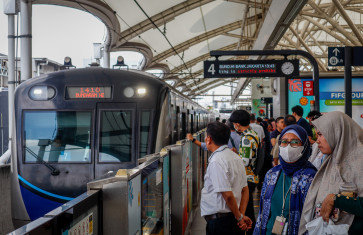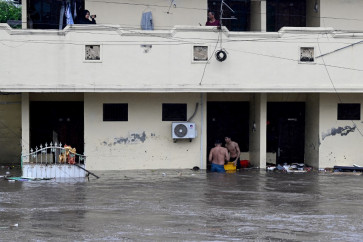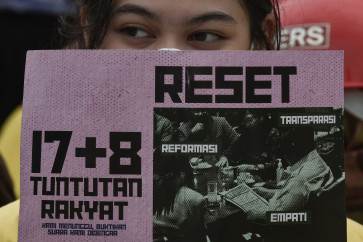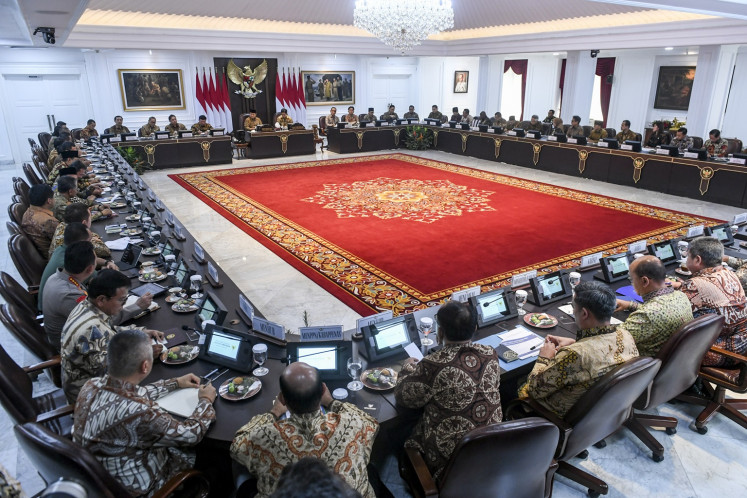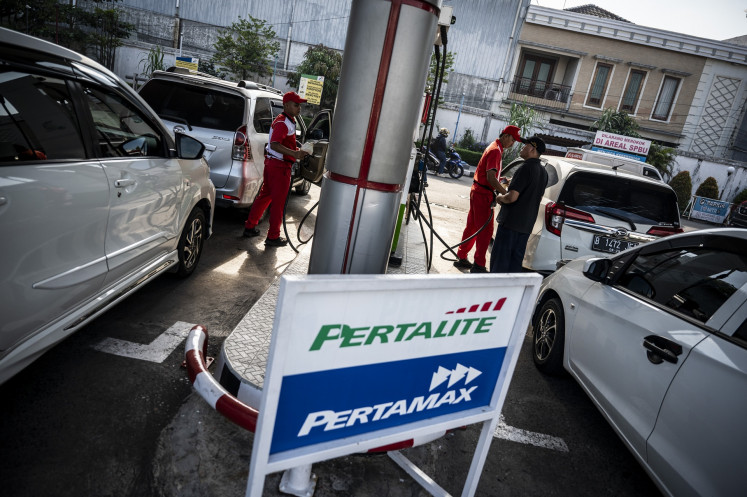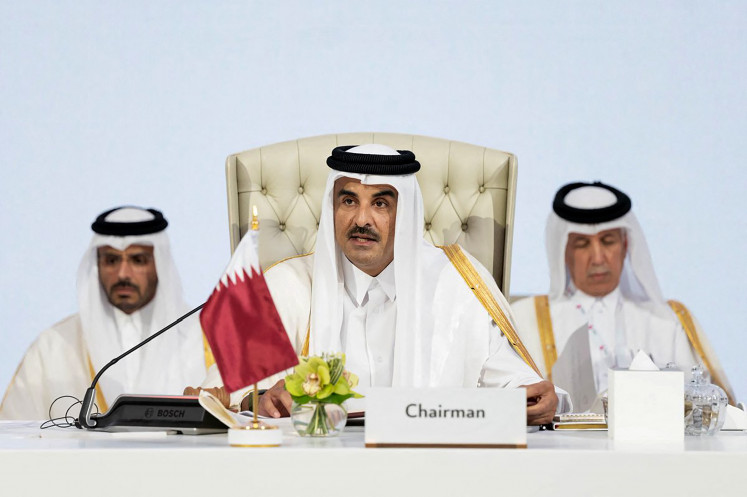Popular Reads
Top Results
Can't find what you're looking for?
View all search resultsPopular Reads
Top Results
Can't find what you're looking for?
View all search resultsDenny JA : Coalition required for a strong government
The big question before an election is always: Who will win? Scientific studies and surveys conducted by poll bodies have helped answer the question
Change text size
Gift Premium Articles
to Anyone
The big question before an election is always: Who will win? Scientific studies and surveys conducted by poll bodies have helped answer the question.
While there are a dozen poll bodies in Indonesia now, the poll culture was only started in 2004 by a poll body called Lembaga Survey Indonesia (Indonesian Survey Institute), established by Denny Januar Ali, Saiful Mujani and M Qodari.
Because of different views, the pollsters broke up into three bodies; Saiful still in the Lembaga Survei Indonesia, Denny with Lingkaran Survei Indonesia (Indonesian Survey Circle), and Qodari with Indo Barometer.
Denny Januar Ali talked to The Jakarta Post about the chances of political parties in this year's legislative election as well as in the presidential election.
What drives change in the election results?
An election is a portrait of dynamic public opinion. Change happens because the public are either satisfied or disappointed with the government, or there are matters affecting the public, such as the financial crisis, new figures or new issues. All factors come together and we get a new government with new political parties.
We see that the face of parliament will change. The Crescent Star Party (PBB) and the Reform Star Party (PBR) will not be part of it. The People's Conscience Party (Hanura) and the Great Indonesia Movement Party (Gerindra) will bask in the sun, while top parties like the Indonesian Democratic Party of Struggle (PDI-P), the Democratic Party and the Golkar Party will continue to shine. The Democratic Party will make the biggest leap from the middle level to the top level.
The Democratic Party will rise due to two important variables. First, Susilo Bambang Yudhoyono has been a popular figure, so it is a figure-based party. Yudhoyono has been working on populist programs, such as government cash aid (BLT), credit and education, as he holds Rp 70 trillion (US$6.1 billion) of stimulus funds for the programs.
Second, the party placed many commercials and advertisements in various media. According to AC Nielsen, the Democratic Party spent the most on advertisements, closely followed by Gerindra.
There are two new parties, Hanura and Gerindra, who shot to fame. What makes them more special than other parties?
First, both parties have had more public exposure through commercials and advertisements compared to other parties. The commercials are important. If they do not buy commercial slots, they will only be featured in news items, which are only watched by the higher class.
The middle and low classes do not watch news, but soap operas and entertainment shows, which is where parties can budge in. According AC Nielsen, the commercial spending of these two parties was bigger than other new parties.
Second, the figure factor. The two parties have big figures like Wiranto and Prabowo, who are publicly known and have track records. Both of them are known by at least 80 percent of the voters. Figures are important. For example, people know the Democratic Party through the figure of Susilo Bambang Yudhoyono, not Hadi Utomo the party leader.
Third, the social network. The leading figures of Hanura and Gerindra used to head departments, Wiranto was chief of the Indonesian Military while Prabowo was chief of the Army's Reserve Strategic Command (Kostrad). They have networks and that helps them in building relations.
They catch the attention of voters at the national level, but it is probably not the case at the local level. There should be a political machine to help the legislative candidates working at the local level.
What about competitors for the presidential election? What will the coalition be like?
The competition of the three parties will continue into the presidential election, where Susilo Bambang Yudhoyono will contend with Megawati and probably Jusuf Kalla. We have yet to know whether there will be a fourth candidate. If there is, it is likely to be Prabowo or Wiranto.
The vice presidential candidates will be determined at the end of April, after the announcement of the General Elections Commission (KPU). However, with the election results being known the same evening through the quick count, it will help them set strategies for coalition and pick the vice president.
I assume SBY will pick his vice president from the professional class, not the political parties, because he wants to be firm as president. If the vice president comes from another political party, political blocking is possible. As for JK and Mega, they will either choose vice presidential candidates from the political parties or from the professionals.
In 2004, the president came from a small party and he had to lobby the bigger parties. In 2009, will the government be more effective?
Even though there are three top parties, it is difficult to imagine a party gaining more than 35 percent of the votes. The parties will have to form coalitions in parliament to reach more than 50 percent.
We see a worrisome trend as parties are tending to gain a smaller percentage of votes. In the 1999 election, if we add all votes going to the PDI-P and Golkar, we get more than 50 percent. But in the 2004 election, the coalition of the two parties did not result in 50 percent.
In 2009, we do not know if it is possible to form a coalition with only two political parties. The government should be formed by at least three political parties, so that they can have a fourth leg in parliament. There should also be an opposition party, to nurture democracy.
Why are religion-based parties not the top parties?
In all of the democratic elections, in 1955, 1999, 2004, we see that Indonesians did not favor religion-based parties. In 1955 the Indonesian National Party (PNI) won the election, in 1999 PDI-P and in 2004 it was the Golkar Party. The winner of the 2009 election will also vary between the three nationalist-based parties. That is what makes Indonesia different to other predominantly Islamic countries.
It is caused by the behavior of Muslim voters. They behave in a religious and pious way, but when it comes to politics, most of them prefer nationalist parties. All religion-based parties can only grow into middle parties because they can only depend on a small segment of the population.
The two parties, Hanura and Gerindra, are also nationalist-based parties.
The number of abstentions is estimated to reach between 30 and 40 percent. Does this figure include the undecided?
It is possible that those who have party preferences will still not vote. The phenomenon of abstention (locally known as golongan putih or golput) exists in all segments. This can be due to various economic or political reasons, or other technical problems that hamper people from casting their vote on voting day.
People with economic reasons prefer working on that day rather than going to the polling station, as they would lose their daily income. They think the winning party would not be able to help improve their lives, so they would be better off working.
People with political reasons feel saturated. They feel that whoever leads the country will not make any progress. So why waste time in polling stations?
In the United States, abstention can reach 50 percent. Usually the more modern a country becomes, the bigger the abstention rate.
The urban dwellers usually abstain for political reasons, while people living in rural areas for economic reasons. So basically nonvoters can be found in all segments of society.
There was a problem with the voters' lists. Will it affect the results and the election process?
The voters' lists problem depends on the numbers. If the rate of alleged voter fraud is between three and five percent, it is simply an administrative problem. But if the rate goes beyond five percent, or up to 10 percent, there would seem to be political bias, especially if it happens systematically in a certain party's areas. If it happens randomly, it affects all parties.
We are worried that it is systematic cheating. But as a scientist, I can only listen and cannot give further comment.


